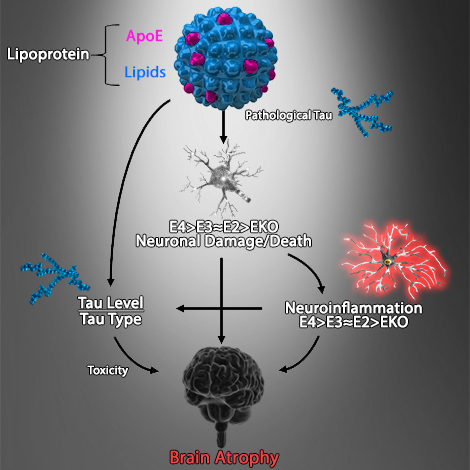 |
| ApoE4 exacerbates tau pathogenesis, neuroinflammation and tau-mediated neurodegeneration, independently of amyloid-β pathology Apolipoproteins, like Apolipoprotein E (ApoE), are proteins that bind lipids to form lipoproteins. While the lipid components of lipoproteins are hydrophobic and insoluble in water, apolipoproteins are amphipathic and are soluble in water. Thus, apolipoproteins facilitate the generation of lipoprotein particles that are water-soluble and can be carried through water-based circulation like blood and lymph. ApoE in the central nervous system (CNS) is produced by astrocytes and microglia, and is a major cholesterol carrier that supports lipid transport and injury repair in the brain. Previous work demonstrated that polymorphic alleles of APOE-ε2, ε3 and ε4-influence amyloid-β deposition in a dose- and isoform-specific fashion (E4>E3>E2), and established that the ε4 allele of APOE is the strongest genetic risk factor for Alzheimer’s Disease (AD). However, the degree to which APOE isoforms exacerbate tau-mediated neurodegeneration has heretofore not been studied. By using mice that overexpress 1N4R human tau containing a P301S mutation, which causes a form of frontotemporal dementia, and breeding these mice to human APOE knock-in or knock-out strains, Shi et al. explored the role of APOE on tau pathology. Shi et al. determined that ApoE4 exacerbates tau-mediated neurodegeneration, independently of amyloid-β pathology, while the lack of ApoE protects against pathology. In support, compared to ApoE3- and ApoE2-expressing mice, ApoE4-expressing mice demonstrated significantly increased volume of the lateral ventricle, concomitant with the loss of tissue in the piriform cortex, hippocampus and loss of the granule layer of the dentate gyrus. Moreover, microglia and astrocytes isolated from ApoE4-expressing mice exhibited a marked upregulation in proinflammatory genes, which contributes to neuroinflammation and neurodegeneration. Most importantly, in vitro treatment of P301S tau-expressing neurons with recombinant ApoE alone led to increased neuronal death and these effects were most prominent when neurons were treated with ApoE4. This data suggests a direct effect of ApoE4 on neurodegeneration. In sum, the authors propose that under pathological tau accumulation, ApoE, and specifically ApoE4, exacerbates neurodegeneration, whereas lack of ApoE dampens neurodegeneration. Dying neurons promote neuroinflammation, which is further amplified by ApoE4 owing to its increased innate immune reactivity, aggravating neurodegeneration further.  Adapted from Shi, et al. 2017. Nature. 549, 523–527. Pubmed Shi et al. determined that ApoE4 exacerbates tau-mediated neurodegeneration, independently of amyloid-β pathology, while the lack of ApoE protects against pathology. In support, compared to ApoE3- and ApoE2-expressing mice, ApoE4-expressing mice demonstrated significantly increased volume of the lateral ventricle, concomitant with the loss of tissue in the piriform cortex, hippocampus and loss of the granule layer of the dentate gyrus. Moreover, microglia and astrocytes isolated from ApoE4-expressing mice exhibited a marked upregulation in proinflammatory genes, which contributes to neuroinflammation and neurodegeneration. Most importantly, in vitro treatment of P301S tau-expressing neurons with recombinant ApoE alone led to increased neuronal death and these effects were most prominent when neurons were treated with ApoE4. This data suggests a direct effect of ApoE4 on neurodegeneration. In sum, the authors propose that under pathological tau accumulation, ApoE, and specifically ApoE4, exacerbates neurodegeneration, whereas lack of ApoE dampens neurodegeneration. Dying neurons promote neuroinflammation, which is further amplified by ApoE4 owing to its increased innate immune reactivity, aggravating neurodegeneration further . |
 |
 |
| Example standard curve generated with the LEGENDplex™ Human Apo Panel (Cat. No. 740454) |
|
 |
| Clone | Target Recognition | Applications |
|---|---|---|
| 5A9 | Human ApoE4 | ELISA, IHC |
| 5B5/ApoE4 | Human ApoE4 | ELISA, IHC |
| D6E10 | Human ApoE (E2, E3 and E4) | ELISA, WB, IHC, IP |
| E6D7 | Human ApoE (E2, E3 and E4) | ELISA, WB, IHC, IP |
| 3B3C32 | Mouse ApoE | WB |
 |
| Clone | Applications |
|---|---|
| Recombinant Human Tau-352 (0N3R) | WB, ELISA |
| Recombinant Human Tau-381 (1N3R) | WB, ELISA |
| Recombinant Human Tau-383 (0N4R) | WB, ELISA |
| Recombinant Human Tau-410 (2N3R) | WB, ELISA |
| Recombinant Human Tau-412 (1N4R) | WB, ELISA |
| Recombinant Human Tau-441 (2N4R) | WB, ELISA |
 |
 |
| Description |
|---|
| LEGENDplex™ Human Apolipoprotein (Apo) Panel (11-plex) with V-bottom Plate |
 |
 |
BioLegend is continually striving to improve our neuroscience offering. Take a moment to fill out this survey, and you’ll be entered into a drawing for a $100 Amazon gift card! |
 |
 Login / Register
Login / Register 






Follow Us